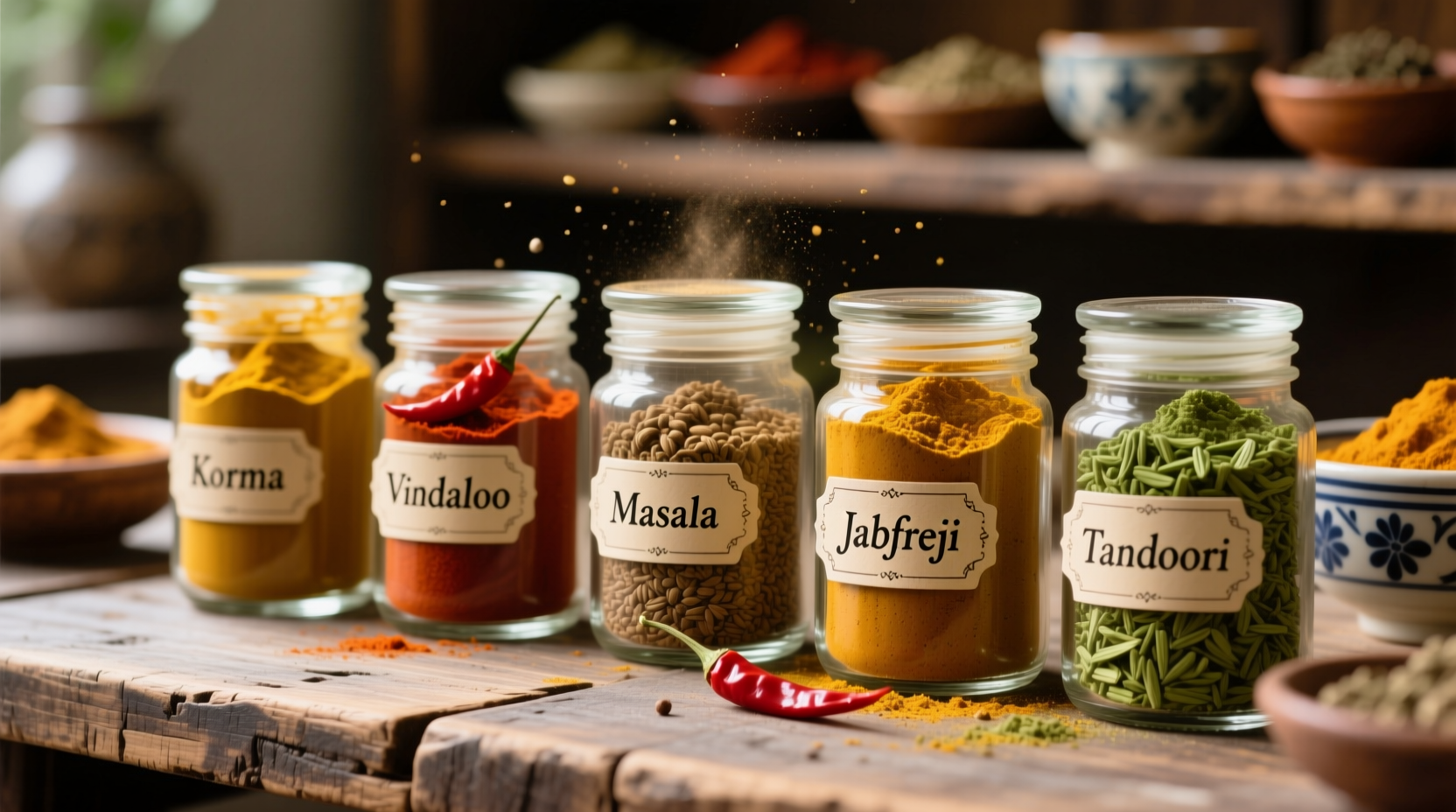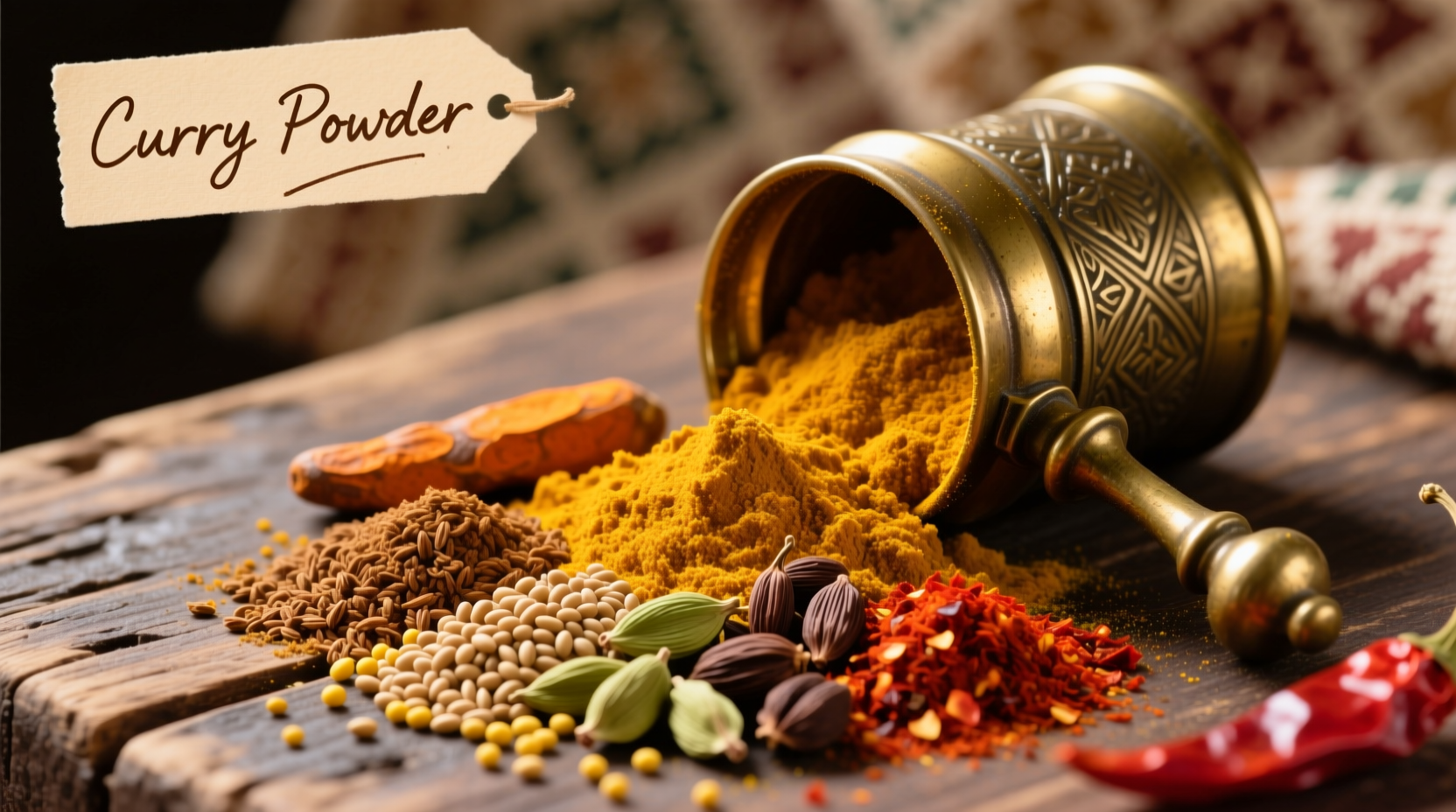Ever wondered what gives curry powder its vibrant color and complex flavor? Understanding the exact spice composition helps you cook with confidence and customize blends to match authentic regional dishes. This guide reveals the essential spices in curry powder, explains how variations differ across cultures, and shows you how to use this versatile blend effectively in your kitchen.
The Essential Spices in Traditional Curry Powder
Curry powder isn't a single, standardized blend but rather a Western interpretation of Indian spice mixtures. The foundational spices remain remarkably consistent across most commercial blends:
| Core Spice | Flavor Profile | Percentage in Blend |
|---|---|---|
| Turmeric | Earthy, slightly bitter, peppery | 20-25% |
| Coriander | Citrusy, floral, nutty | 15-20% |
| Cumin | Warm, earthy, slightly smoky | 15-20% |
| Fenugreek | Sweet, nutty, maple-like | 10-15% |
| Ginger | Spicy, warm, slightly sweet | 5-10% |
| Black Pepper | Sharp, pungent, warming | 5-10% |
According to research published by the National Center for Biotechnology Information, these core spices work synergistically—the curcumin in turmeric increases bioavailability of other compounds, while black pepper's piperine enhances absorption of turmeric's active ingredients.
How Regional Variations Transform the Blend
Curry powder evolved differently across regions, reflecting local tastes and available ingredients. The British colonial interpretation differs significantly from authentic Indian spice mixes:

British-Style Curry Powder (The Western Standard)
Developed during the British Raj, this version emphasizes turmeric for color and includes:
- Turmeric (for vibrant yellow color)
- Coriander (for citrus notes)
- Cumin (for earthiness)
- Fenugreek (for subtle sweetness)
- Additional spices like mustard seed or chili for heat
This blend became popularized through commercial products like Madras curry powder, which typically includes more chili for heat.
Indian Regional Variations
It's crucial to understand that "curry powder" as sold in Western markets doesn't exist in traditional Indian cooking. Instead, Indian households use custom blends called masalas:
- Garam Masala: Used in North Indian cuisine, contains warming spices like cardamom, cloves, and cinnamon
- Sambar Powder: South Indian blend with lentils, tamarind, and more chili
- Vindaloo Powder: Goan blend featuring Kashmiri chilies and mustard seeds
The Encyclopedia Britannica notes that authentic Indian cooking typically uses freshly ground spices rather than pre-mixed powders, allowing for greater flavor complexity and freshness.
Curry Powder vs. Curry Pastes: Understanding the Difference
Many home cooks confuse curry powder with curry pastes, but they're fundamentally different:
| Characteristic | Curry Powder | Curry Paste |
|---|---|---|
| Base Ingredients | Dried spices only | Fresh ingredients + dried spices |
| Texture | Fine powder | Thick paste |
| Shelf Life | 6-12 months | 1-2 weeks refrigerated |
| Typical Use | Dry rubs, finishing spice | Base for sauces and stews |
| Regional Origin | British interpretation | Authentic Thai, Indian preparations |
Thai curry pastes, for example, contain fresh galangal, lemongrass, and kaffir lime leaves—ingredients that can't be replicated in a dry powder form. This explains why substituting curry powder for curry paste often yields disappointing results.
How to Choose and Use Curry Powder Effectively
Not all curry powders are created equal. Follow these professional tips to select and use the best product:
Reading Labels Like a Pro
Check for these quality indicators:
- Ingredient transparency: Should list specific spices, not "spice blend"
- No fillers: Avoid products with wheat flour, rice flour, or maltodextrin
- Freshness indicators: Look for "packed on" dates rather than just "best by" dates
- Color intensity: Vibrant yellow indicates fresh turmeric (dull yellow suggests aged product)
Storage Techniques That Preserve Flavor
Spices lose potency quickly when exposed to light, air, and moisture. Follow these storage guidelines:
- Store in airtight glass containers away from heat sources
- Keep away from direct sunlight (cabinet storage preferred over spice racks)
- Buy in small quantities—curry powder loses 30% of its flavor compounds within 6 months
- Freeze for long-term storage (up to 2 years)
Research from the University of Minnesota Extension confirms that proper storage significantly extends the shelf life and flavor intensity of spice blends.
Make Your Own Curry Powder: A Customizable Recipe
Creating your own curry powder ensures maximum freshness and allows customization. This basic recipe forms the foundation for countless variations:
Classic Curry Powder Recipe
- ¼ cup coriander seeds
- 2 tablespoons cumin seeds
- 1½ tablespoons turmeric powder
- 1 tablespoon fenugreek seeds
- 1 tablespoon mustard seeds
- 1 tablespoon ginger powder
- 1½ teaspoons black peppercorns
- 1 teaspoon cardamom pods
- ½ teaspoon cloves
Customization Options
Adjust this base recipe to create regional variations:
- Madras Style: Add 1-2 teaspoons cayenne pepper
- Sweet Curry: Increase fenugreek to 2 tablespoons, add ½ teaspoon cinnamon
- Vindaloo Style: Add 1 teaspoon mustard seeds and ½ teaspoon tamarind powder
Professional tip: Toast whole spices in a dry skillet over medium heat for 2-3 minutes until fragrant before grinding. This process, documented in Scientific American, releases essential oils and dramatically enhances flavor complexity.
When to Use Curry Powder (And When Not To)
Understanding the limitations of curry powder prevents culinary disappointment:
- Ideal for: Western-style curries, dry rubs for proteins, seasoning roasted vegetables, enhancing soups and stews
- Not suitable for: Authentic Indian or Thai curries (use fresh spice blends instead), delicate fish dishes (overpowering), cold preparations (requires cooking to develop flavor)
Remember that curry powder works best when bloomed in oil at the beginning of cooking—a technique that unlocks maximum flavor. Simply sprinkling it on at the end won't deliver the same depth of flavor.
Frequently Asked Questions
Is curry powder the same as garam masala?
No, they're distinct blends. Garam masala is a North Indian spice mix typically containing cardamom, cloves, and cinnamon without turmeric, while curry powder is a Western creation featuring turmeric as its primary ingredient. Garam masala translates to "warming spice mix" and is usually added at the end of cooking, whereas curry powder needs to be cooked to develop its flavor.
Can I substitute curry powder for curry paste?
Not directly. Curry powder lacks the fresh ingredients (like lemongrass, galangal, and kaffir lime) found in curry pastes. For Thai curries, use 1 tablespoon curry powder plus 1 teaspoon lemon juice and ½ teaspoon ginger paste per tablespoon of curry paste required. The flavor won't be identical but provides a reasonable approximation.
Why does my curry powder taste bitter?
Bitterness usually comes from two sources: expired spices (especially turmeric) or burning the spices during cooking. Curry powder should be bloomed in oil for just 1-2 minutes over medium heat—any longer and the spices will burn. For best results, use fresh curry powder (less than 6 months old) and cook it gently in oil before adding liquids.
Is curry powder spicy hot?
Not necessarily. Traditional curry powder contains black pepper for warmth but isn't inherently hot. The heat level depends on additional ingredients—Madras curry powder includes chili peppers for heat, while sweet curry powder contains little to no heat. Many commercial blends are actually quite mild, with turmeric providing color rather than heat.
Can I make curry powder without turmeric?
Yes, but it won't be traditional curry powder. Turmeric provides the characteristic yellow color and earthy base flavor. Without it, you'd essentially be making a garam masala variation. If avoiding turmeric for dietary reasons, substitute with a small amount of saffron (expensive) or annatto seed for color, plus extra coriander and cumin for flavor balance.











 浙公网安备
33010002000092号
浙公网安备
33010002000092号 浙B2-20120091-4
浙B2-20120091-4